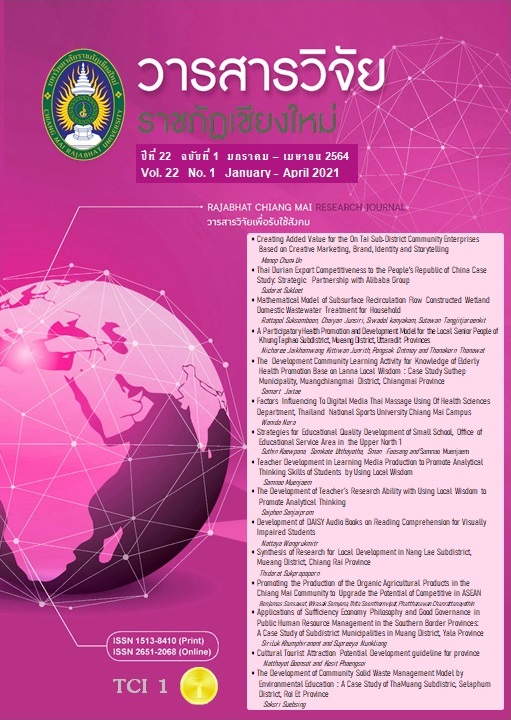Development of DAISY Audio Books on Reading Comprehension for Visually Impaired Students
DOI:
https://doi.org/10.14456/rcmrj.2021.236288Keywords:
DAISY Book, Reading Comprehension skills, Visually impaired studentsAbstract
The objectives of this research were: 1) to develop DAISY audio books on Reading Comprehension for visually impaired students to attain the criterion of 70/70 standard, 2) to study Effectiveness Index of DAISY audio books, 3) to compare learning achievement on reading comprehension by using pretest and posttest after using DAISY audio books.
The research population were 6 Mattayomsuksa 3 visually impaired students of the Northern School for the Blind under patronage of the Queen studying in 2018 academic year. The research tools utilized in this study were DAISY audio books on Reading Comprehension, instructional Manual, pretest and posttest. Data were analyzed by using percentage, mean, standard deviation, and Effectiveness Index.
The research result showed that: 1) the efficiency of DAISY audio books on Reading Comprehension for visually impaired students attained the criterion of 70/70 standard at 80.00/75.80; 2) the Effectiveness Index of DAISY audio books on Reading Comprehension was at 0.70 ; and the learning achievement on reading comprehension after using DAISY audio books was higher.
Downloads
References
Bunton, M. (1999). Handbook of volunteers. Develop the quality of life of the blind. Association of the blind. Bangkok: Thiranusorn printing. (In Thai)
Government Gazette. (2008). Education Management for Persons with Disabilities Act 2008. (2008). Government Gazette. Volume 125. (In Thai)
Hallahan, D., & James, K. (1982). Exceptional Children : Introduction to Special Education. New Jursey : Prentice Hall Inc.
Krittayakier, O. (2007). A Program Supporting DAISY Digital Audio Book Creation. Bangkok: Chulalongkorn University. (In Thai)
Niamnoi, A. (2008). Development of critical reading using the SQ3R method. Bangkok: Suwiriyasarn. (In Thai)
Pholam, M. (2013). Development of Computer-Assisted Multimedia Lessons. ASEAN Community matters for Visually impaired students Ramkhamhaeng University. (Master of Education Thesis in Educational technology and communication, Kasetsart University). (In Thai)
Phongsawat, N. (2015). Content needs of the visually impaired. To produce audio books on the application Read for the Blind. (Independent research of Strategic Communication Program, Graduate School Bangkok University). (In Thai)
Samranwet, P. (2010). The teaching condition of English at the secondary level. In schools for the blind and in schools In the project of co-teaching blind students. (Master of Education Thesis, Chulalongkorn University). (In Thai)
Subsakorn, W. (1995). A study of problems and solutions related to the production and use of teaching materials in schools for the blind. (Master's thesis, Faculty of Education, Chulalongkorn University). (In Thai)
Downloads
Published
How to Cite
Issue
Section
License
1. Articles, information, content, images, etc published in the “Community and Social Development Journal” are copyrighted by the Community and Social Development Journal, Chiang Mai Rajabhat University. In order to properly distribute the articles through print and electronic media, the authors still hold the copyright for the published articles under the Creative Commons Attribution (CC BY) license, which allows the re-distribution of the articles in other sources. References must be made to the articles in the journal. The authors are responsible for requesting permission to reproduce copyrighted content from other sources.
2. The content of the articles appearing in the journal is the direct responsibility of the article authors. The editorial board of the journal does not necessarily agree with or share any responsibility.














